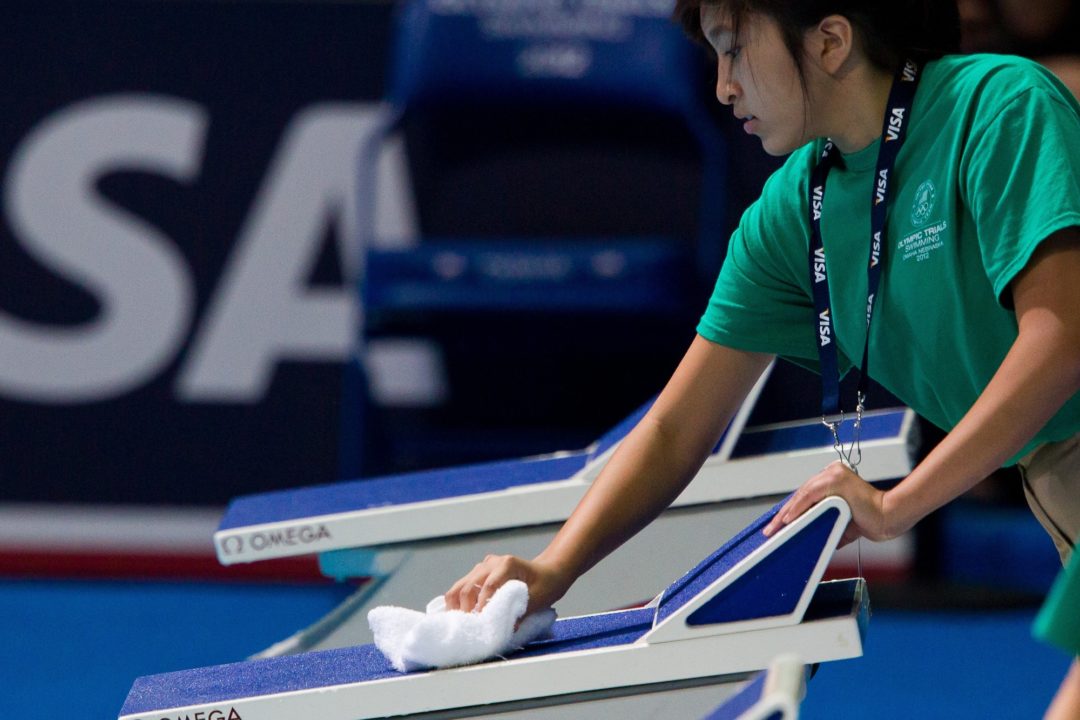In a small tidbit of pre-NCAA Championship news, athletes will not be allowed to remove the kick-plates on the starting blocks at the women’s NCAA Championship at the University of Minnesota.
Minnesota just got new blocks this year, and the kick plates are removable, and the implication is that there were teams that were requesting the ability to remove them during the meet altogether (rather than just adjust them). During the teleconference on February 5th, 2014 of the NCAA Division I Men’s and Women’s Swimming and Diving Committee, though, it was decided that the kick plates would not be allowed to be taken out for NCAA’s.
Those we spoke to who swam at the Big Ten women’s championship meet held there last weekend said that before relays, someone would ask each relay if they wanted the kick-plates removed, and would then remove it if requested. A relay, where a swimmer might be used to a certain space for stepping, would be the most logical time when someone would want these plates removed.
The new Minnesota blocks are made by Spectrum, and to remove the kick-plate, they must be slid off of the front of the block. SwimSwam senior reporter Jared Anderson, who trains at Minnesota, tells us that it’s a pretty easy motion to do, but is a little bit awkward because you have to lean out over the water to get them off.
The official report of the teleconference reads as follows:
“The committee reviewed the starting blocks, and specifically the kick-plates, for the women’s championships and voted to not allow student-athletes/teams to remove kick-plates during the championships. Rationale for restricting removal of the kick-plates include potential delays in the meet, issues with the kick-plates not being secure properly, risk of the kick-plates falling into the pool and lack of experience of some student-athletes/teams with the type of starting blocks. The policy will be clearly outlined in the participant manual and will be addressed in the administrative meeting.
In other news out of that meeting, pertaining specifically to diving, a primary “balk judge” would be secured for diving at the Division I men’s and women’s championships. If possible, the committee would like to test electronic balk-judging equipment in 2014 for potential inclusion in future championships.
The balk judge’s primary function is to be on the platform with the diver to determine if the diver’s foot touches the platform on a handstand dive after a diver has begun an armstand. The balk judge also ensures that on these handstands, swimmers are not allowed to move their hands once the handstand is begun.

I would have to respectfully disagree that the person in the picture is a gentleman.
Also, weird block design. I love kick plates and starting handles, but it’s like Spectrum didn’t even think of the 200 free relay when making these.
Actually, divers are no longer permitted to move their hands once both feet have left the platform in the start of the armstand. The rule was changed to be in line with FINA standards about five years ago. This is most likely why the balk judge, has become more important. This person is responsible for making sure the hands remain still prior to the dive being executed.
Thanks Tom, must’ve missed the update to the rules. Will amend above.
Thanks Tom, must’ve missed the rules change. Corrected above.
I personally liked the kick-plates during my own individual race, but prefer to have them completely off for a relay pick-up. Like stated, it just gives you more room. However, I do understand why they’d want to keep them on, especially for safety reasons. When I went to slide my kick-plate off during a warm up, the unexpected weight of it caught me off guard and I did almost drop it into the pool.